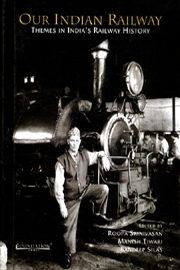Book contents
- Frontmatter
- Contents
- Foreword
- Preface
- Introduction
- 1 The Colonial Context of the Bengal Renaissance: A Note on Early Railway–Thinking in Bengal
- 2 Minute by Dalhousie on Introduction of Railways in India, as Submitted to the Court of Directors, 4 July 1850
- 3 Ackworth Committee Report
- 4 Competition and Adaptation: The Operation of Railways in Northern India: Uttar Pradesh 1860–1914
- 5 Economic Nationalism and the Railway Debate, circa 1880-1905
- 6 Railway Policing and Security in Colonial India, c. 1860–1930
- 7 Indian Nationalism and Railways
- 8 The Railway in Colonial India: Between Ideas and Impacts
- 9 The Dark Side of the Force: Mistakes, Mismanagement and the Malfeasance in Early Railways of the British Indian Empire
- 10 Tunnels and Bridges: Railways, Narrative and Power in two Novels of India
- 11 A View of the History of Indian Railways
- 12 The Romance of Steam
- Index
- Plate section
7 - Indian Nationalism and Railways
Published online by Cambridge University Press: 26 October 2011
- Frontmatter
- Contents
- Foreword
- Preface
- Introduction
- 1 The Colonial Context of the Bengal Renaissance: A Note on Early Railway–Thinking in Bengal
- 2 Minute by Dalhousie on Introduction of Railways in India, as Submitted to the Court of Directors, 4 July 1850
- 3 Ackworth Committee Report
- 4 Competition and Adaptation: The Operation of Railways in Northern India: Uttar Pradesh 1860–1914
- 5 Economic Nationalism and the Railway Debate, circa 1880-1905
- 6 Railway Policing and Security in Colonial India, c. 1860–1930
- 7 Indian Nationalism and Railways
- 8 The Railway in Colonial India: Between Ideas and Impacts
- 9 The Dark Side of the Force: Mistakes, Mismanagement and the Malfeasance in Early Railways of the British Indian Empire
- 10 Tunnels and Bridges: Railways, Narrative and Power in two Novels of India
- 11 A View of the History of Indian Railways
- 12 The Romance of Steam
- Index
- Plate section
Summary
Indian railways are as old as Indian nationalism. The earliest rumblings of political discontent as well as of the railroads were in the 1850s when local and provincial associations were formed and the first railway line was opened for operation from Bombay to Thane. The revolt of 1857 may not have been the first war of independence but it certainly revealed enormous popular resentment against alien rule and was disruptive enough to stop railway construction for a while.
Early Nationalists and Railways
The imperial rulers of course presented the introduction of railways as a great boon to India, made possible by its association with Britain. In fact, the emergence of Indian nationalism was attributed by them the benign policies of modernization, Western education and the coming of the railways, which imparted unity to a country, which was merely a congerie of warring states before the coming of the British. The Indian nationalists, however, bought none of this.
A critique of railway policy was an integral part of economic nationalism, the foundational phase of the Indian national movement. Colonial economic policy was subjected to close scrutiny by some of the best minds of that era, Dadabhai Naoroji, R.C. Dutt and G.V. Joshi, among others. Colonial railway policy exposed, as little else did, the stranglehold of metropolitan capital. One obvious target of nationalist ire was the guaranteed five per cent return on investment. According to them, it formed an important component of the drain of wealth from India, which fuelled England's industrial engine, to use an analogy from the railroad.
- Type
- Chapter
- Information
- Our Indian RailwayThemes in India's Railway History, pp. 155 - 172Publisher: Foundation BooksPrint publication year: 2006



